Expression of the Calcitonin Receptor-like Receptor (CALCRL) in Normal and Neoplastic Tissues
Abstract
1. Introduction
2. Results
2.1. Evaluation of the Specificity of the Rabbit Anti-Human CALCRL Antibody
2.2. Immunohistochemical Detection of CALCRL Expression in Normal Human, Rat, and Mouse Tissues
2.3. Immunohistochemical Detection of CALCRL Expression in Various Human Tumour Entities
3. Discussion
3.1. Evaluation of the Specificity of the Rabbit Anti-Human CALCRL Antibody
3.2. Immunohistochemical Detection of CALCRL Expression in Normal Human Tissues
3.3. Immunohistochemical Detection of CALCRL Expression in Human Neoplastic Tissues
4. Materials and Methods
4.1. Antibody
4.2. Western Blot Analysis
4.3. Immunocytochemistry
4.4. Immunohistochemical Evaluation of CALCRL Expression in Normal and Neoplastic Tissues
4.4.1. Tissue Specimens
4.4.2. Immunohistochemistry
5. Conclusions
Supplementary Materials
Author Contributions
Funding
Institutional Review Board Statement
Informed Consent Statement
Data Availability Statement
Conflicts of Interest
Abbreviations
References
- Hay, D.L.; Garelja, M.L.; Poyner, D.R.; Walker, C.S. Update on the pharmacology of calcitonin/CGRP family of peptides: IUPHAR Review 25. Br. J. Pharmacol. 2018, 175, 3–17. [Google Scholar] [CrossRef] [PubMed]
- Hay, D.L.; Pioszak, A.A. Receptor activity-modifying proteins (RAMPs): New insights and roles. Annu. Rev. Pharmacol. Toxicol. 2016, 56, 469–487. [Google Scholar] [CrossRef] [PubMed]
- Gingell, J.J.; Hendrikse, E.R.; Hay, D.L. New insights into the regulation of CGRP-family receptors. Trends Pharmacol. Sci. 2019, 40, 71–83. [Google Scholar] [CrossRef]
- Russell, F.A.; King, R.; Smillie, S.J.; Kodji, X.; Brain, S.D. Calcitonin gene-related peptide: Physiology and pathophysiology. Physiol. Rev. 2014, 94, 1099–1142. [Google Scholar] [CrossRef] [PubMed]
- Hay, D.L.; Chen, S.; Lutz, T.A.; Parkes, D.G.; Roth, J.D. Amylin: Pharmacology, physiology, and clinical potential. Pharmacol. Rev. 2015, 67, 564–600. [Google Scholar] [CrossRef] [PubMed]
- Ozcelik, F.; Pence, H.H.; Ozturkeri, H.Y.; Sertoğlu, E. Adrenomedullin as a protein with multifunctional behavior and effects in various organs and tissues. IJNR 2019, 1, 12–29. [Google Scholar] [CrossRef]
- Fischer, J.P.; Els-Heindl, S.; Beck-Sickinger, A.G. Adrenomedullin—Current perspective on a peptide hormone with significant therapeutic potential. Peptides 2020, 131, 170347. [Google Scholar] [CrossRef]
- Edvinsson, L.; Edvinsson, J.C.A.; Haanes, K.A. Biological and small molecule strategies in migraine therapy with relation to the calcitonin gene-related peptide family of peptides. Br. J. Pharmacol. 2021, 179, 371–380. [Google Scholar] [CrossRef]
- Vásquez, R.; Riveiro, M.E.; Berenguer-Daizé, C.; O’Kane, A.; Gormley, J.; Touzelet, O.; Rezai, K.; Bekradda, M.; Ouafik, L. Targeting adrenomedullin in oncology: A feasible strategy with potential as much more than an alternative anti-angiogenic therapy. Front. Oncol. 2021, 10, 589218. [Google Scholar] [CrossRef]
- Edvinsson, L. Calcitonin gene-related peptide (CGRP) is a key molecule released in acute migraine attacks—Successful translation of basic science to clinical practice. J. Intern. Med. 2022, 292, 575–586. [Google Scholar] [CrossRef]
- Chesnut, C.H.; Azria, M.; Silverman, S.; Engelhardt, M.; Olson, M.; Mindeholm, L. Salmon calcitonin: A review of current and future therapeutic indications. Osteoporos. Int. 2008, 19, 479–491. [Google Scholar] [CrossRef]
- Robblee, J.; Harvey, L.K. Cardiovascular disease and migraine: Are the new treatments safe? Curr. Pain Headache Rep. 2022, 26, 647–655. [Google Scholar] [CrossRef]
- Younk, L.M.; Mikeladze, M.; Davis, S.N. Pramlintide and the treatment of diabetes: A review of the data since its introduction. Expert Opin. Pharmacother. 2011, 12, 1439–1451. [Google Scholar] [CrossRef] [PubMed]
- Zudaire, E.; Martínez, A.; Cuttitta, F. Adrenomedullin and cancer. Regul. Pept. 2003, 112, 175–183. [Google Scholar] [CrossRef] [PubMed]
- Oliver, K.R.; Wainwright, A.; Edvinsson, L.; Pickard, J.D.; Hill, R.G. Immunohistochemical localization of calcitonin receptor-like receptor and receptor activity-modifying proteins in the human cerebral vasculature. J. Cereb. Blood Flow Metab. 2002, 22, 620–629. [Google Scholar] [CrossRef] [PubMed]
- Lennerz, J.K.; Ruhle, V.; Ceppa, E.P.; Neuhuber, W.L.; Bunnett, N.W.; Grady, E.F.; Messlinger, K. Calcitonin receptor-like receptor (CLR), receptor activity-modifying protein 1 (RAMP1), and calcitonin gene-related peptide (GCRP) immunoreactivity in the rat trigeminovascular system: Differences between peripheral and central CGRP receptor distribution. J. Comp. Neurol. 2008, 507, 1277–1299. [Google Scholar] [CrossRef] [PubMed]
- Eftekhari, S.; Salvatore, C.A.; Calamari, A.; Kane, S.A.; Tajti, J.; Edvinsson, L. Differential distribution of calcitonin gene-related peptide and its receptor components in the human trigeminal ganglion. Neuroscience 2010, 169, 683–696. [Google Scholar] [CrossRef]
- Eftekhari, S.; Edvinsson, L. Calcitonin gene-related peptide (CGRP) and its receptor components in human and rat spinal trigeminal nucleus and spinal cord at C1-level. BMC Neurosci. 2011, 12, 112. [Google Scholar] [CrossRef] [PubMed]
- Eftekhari, S.; Warfvinge, K.; Blixt, F.W.; Edvinsson, L. Differentiation of nerve fibers storing CGRP and CGRP receptors in the peripheral trigeminovascular system. J. Pain. 2013, 14, 1289–1303. [Google Scholar] [CrossRef] [PubMed]
- Eftekhari, S.; Salvatore, C.A.; Johansson, S.; Chen, T.; Zeng, Z.; Edvinsson, L. Localization of CGRP, CGRP receptor, PACAP and glutamate in trigeminal ganglion. Relation to the blood–brain barrier. Brain Res. 2015, 1600, 93–109. [Google Scholar] [CrossRef] [PubMed]
- Miller, S.; Liu, H.; Warfvinge, K.; Shi, L.; Dovlatyan, M.; Xu, C.; Edvinsson, L. Immunohistochemical localization of the calcitonin gene-related peptide binding site in the primate trigeminovascular system using functional antagonist antibodies. Neuroscience 2016, 328, 165–183. [Google Scholar] [CrossRef] [PubMed]
- Edvinsson, J.C.A.; Warfvinge, K.; Krause, D.N.; Blixt, F.W.; Sheykhzade, M.; Edvinsson, L.; Haanes, K.A. C-fibers may modulate adjacent Aδ-fibers through axon-axon CGRP signalling at nodes of Ranvier in the trigeminal system. J. Headache Pain 2019, 20, 105. [Google Scholar] [CrossRef] [PubMed]
- Edvinsson, L.; Grell, A.S.; Warfvinge, K. Expression of the CGRP family of neuropeptides and their receptors in the trigeminal ganglion. J. Mol. Neurosci. 2020, 70, 930–944. [Google Scholar] [CrossRef] [PubMed]
- Edvinsson, J.C.A.; Reducha, P.V.; Sheykhzade, M.; Warfvinge, K.; Haanes, K.A.; Edvinsson, L. Neurokinins and their receptors in the rat trigeminal system: Differential localization and release with implications for migraine pain. Mol. Pain. 2021, 17, 1–11. [Google Scholar] [CrossRef] [PubMed]
- Edvinsson, L.; Eftekhari, S.; Salvatore, C.A.; Warfvinge, K. Cerebellar distribution of calcitonin gene-related peptide (CGRP) and its receptor components calcitonin receptor-like receptor (CLR) and receptor activity modifying protein 1 (RAMP1) in rat. Mol. Cell. Neurosci. 2011, 46, 333–339. [Google Scholar] [CrossRef]
- Csati, A.; Tajti, J.; Tuka, B.; Edvinsson, L.; Warfvinge, K. Calcitonin gene-related peptide and its receptor components in the human sphenopalatine ganglion—Interaction with the sensory system. Brain Res. 2012, 1435, 29–39. [Google Scholar] [CrossRef]
- Eftekhari, S.; Salvatore, C.A.; Gaspar, R.C.; Roberts, R.; O’Malley, S.; Zeng, Z.; Edvinsson, L. Localization of CGRP receptor components, CGRP, and receptor binding sites in human and rhesus cerebellar cortex. Cerebellum 2013, 12, 937–949. [Google Scholar] [CrossRef]
- Eftekhari, S.; Gaspar, R.C.; Roberts, R.; Chen, T.B.; Zeng, Z.; Villarreal, S.; Edvinsson, L.; Salvatore, C.A. Localization of CGRP receptor components and receptor binding sites in rhesus monkey brainstem: A detailed study using in situ hybridization, immunofluorescence, and autoradiography. J. Comp. Neurol. 2016, 524, 90–118. [Google Scholar] [CrossRef]
- Warfvinge, K.; Edvinsson, L.; Pickering, D.S.; Sheykhzade, M. The presence of calcitonin gene-related peptide and its receptors in rat, pig and human brain: Species differences in calcitonin gene-related peptide pharmacology. Pharmacology 2019, 104, 332–341. [Google Scholar] [CrossRef]
- Blixt, F.W.; Radziwon-Balicka, A.; Edvinsson, L.; Warfvinge, K. Distribution of CGRP and its receptor components CLR and RAMP1 in the rat retina. Exp. Eye Res. 2017, 161, 124–131. [Google Scholar] [CrossRef]
- Warfvinge, K.; Edvinsson, L. Distribution of CGRP and CGRP receptor components in the rat brain. Cephalgia 2019, 39, 342–353. [Google Scholar] [CrossRef] [PubMed]
- Edvinsson, L.; Ahnstedt, H.; Larsen, R.; Sheykhzade, M. Differential localization and characterization of functional calcitonin gene-related peptide receptors in human subcutaneous arteries. Acta Physiol. 2014, 210, 811–822. [Google Scholar] [CrossRef] [PubMed]
- Bühlmann, N.; Aldecoa, A.; Leuthäuser, K.; Gujer, R.; Muff, R.; Fischer, J.A.; Born, W. Glycosylation of the calcitonin receptor-like receptor at Asn60 or Asn112 is important for cell surface expression. FEBS Lett. 2000, 486, 320–324. [Google Scholar] [CrossRef] [PubMed]
- Hilairet, S.; Foord, S.M.; Marshall, F.H.; Bouvier, M. Protein-protein interaction and not glycosylation determines the binding selectivity of heterodimers between the calcitonin receptor-like receptor and the receptor activity-modifying proteins. J. Biol. Chem. 2001, 276, 29575–29581. [Google Scholar] [CrossRef] [PubMed]
- Uddman, R.; Edvinsson, L.; Ekblad, E.; Hakanson, H.; Sundler, F. Calcitonin gene-related peptide (CGRP): Perivascular distribution and vasodilatory effects. Reg. Pept. 1986, 15, 1–23. [Google Scholar] [CrossRef] [PubMed]
- Edvinsson, L.; Ekman, R.; Jansen, I.; Ottosson, A.; Uddman, R. Peptide-containing nerve fibers in human cerebral arteries: Immunohistochemistry, radioimmunoassay, and in vitro pharmacology. Ann Neurol. 1987, 21, 431–437. [Google Scholar] [CrossRef]
- Wimalawansa, S.J. Calcitonin gene-related peptide and its receptors: Molecular genetics, physiology, pathophysiology, and therapeutic potentials. Endocr. Rev. 1996, 17, 533–585. [Google Scholar] [CrossRef]
- Edvinsson, L.; Goadsby, P.J.; Uddman, R. Amylin: Localization, effects on cerebral arteries and on local cerebral blood flow in the cat. Sci. World J. 2001, 1, 168–180. [Google Scholar] [CrossRef]
- Eftekhari, S.; Edvinsson, L. Possible sites of action of the new calcitonin gene-related peptide receptor antagonists. Ther. Adv. Neurol. Disord. 2010, 3, 369–378. [Google Scholar] [CrossRef]
- Erdling, A.; Sheykhzade, M.; Edvinsson, L. Differential inhibitory response to telcagepant on αCGRP induced vasorelaxation and intracellular Ca2+ levels in the perfused and non-perfused isolated rat middle cerebral artery. J. Headache Pain 2017, 18, 61. [Google Scholar] [CrossRef]
- Theuerle, J.; Farouque, O.; Vasanthakumar, S.; Patel, S.K.; Burrell, L.M.; Clark, D.J.; Al-Fiadh, A.H. Plasma endothelin-1 and adrenomedullin are associated with coronary artery function and cardiovascular outcomes in humans. Int. J. Cardiol. 2019, 291, 168–172. [Google Scholar] [CrossRef] [PubMed]
- Holzmann, B. Modulation of immune responses by the neuropeptide CGRP. Amino Acids 2013, 45, 1–7. [Google Scholar] [CrossRef] [PubMed]
- Pedreño, M.; Morell, M.; Robledo, G.; Souza-Moreira, L.; Forte-Lago, I.; Caro, M.; O’Valle, F.; Ganea, D.; Gonzalez-Rey, E. Adrenomedullin protects from experimental autoimmune encephalomyelitis at multiple levels. Brain Behav. Immun. 2014, 37, 152–163. [Google Scholar] [CrossRef] [PubMed]
- Baral, P.; Umans, B.D.; Li, L.; Wallrapp, A.; Bist, M.; Kirschbaum, T.; Wei, Y.; Zhou, Y.; Kuchroo, V.K.; Burkett, P.R.; et al. Nociceptor sensory neurons suppress neutrophil and γδT cell responses in bacterial lung infections and lethal pneumonia. Nat. Med. 2018, 24, 417–426. [Google Scholar] [CrossRef]
- Nagashima, H.; Mahlakoiv, T.; Shih, H.Y.; Davis, F.P.; Meylan, F.; Huang, Y.; Harrison, O.J.; Yao, C.; Mikami, Y.; Urban, J.F.; et al. Neuropeptide CGRP limits group 2 innate lymphoid cell responses and constrains type 2 inflammation. Immunity 2019, 51, 682–695. [Google Scholar] [CrossRef]
- Tilakaratne, N.; Sexton, P.M. CGRP and adrenomedullin in the brain. In Handbook of Biologically Active Peptides; Academic Press: San Diego, CA, USA, 2006; pp. 771–778. [Google Scholar]
- Oliver, K.R.; Kane, S.A.; Salvatore, C.A.; Mallee, J.J.; Kinsey, A.M.; Koblan, K.S.; Keyvan-Fouladi, N.; Heavens, R.P.; Wainwright, A.; Jacobson, M.; et al. Cloning, characterization and central nervous system distribution of receptor activity modifying proteins in the rat. Eur. J. Neurosci. 2001, 14, 618–628. [Google Scholar] [CrossRef]
- Stachniak, T.; Krukoff, T. Receptor activity modifying protein 2 distribution in the rat central nervous system and regulation by changes in blood pressure. J. Neuroendocrinol. 2003, 15, 840–850. [Google Scholar] [CrossRef]
- Hendrikse, E.R.; Rebekah, L.; Bower, R.L.; Hay, D.L.; Walker, C.S. Molecular studies of CGRP and the CGRP family of peptides in the central nervous system. Cephalgia 2019, 39, 403–419. [Google Scholar] [CrossRef]
- Martinez, A. Adrenomedullin and related peptides in the local regulation of endocrine glands. In Handbook of Biologically Active Peptides; Academic Press: Waltham, MA, USA, 2006; pp. 861–867. [Google Scholar]
- Lombardero, M.; Kovacs, K.; Horvath, E.; Scheithauer, B.W.; Rotondo, F.; Salehi, F.; Lloyd, R.V. 2008. Adrenomedullin expression in pituitary adenomas and nontumoral adenohypophyses. Histol. Histopathol. 2008, 23, 11–17. [Google Scholar]
- Rotondo, F.; Vidal, S.; Bell, D.; Horvath, E.; Kovacs, K.; Scheithauer, B.W.; Lloyd, R.V. Immunohistochemical localization of amylin in human pancreas, thyroid, pituitary and their tumors. Acta Histochem. 2003, 105, 303–307. [Google Scholar] [CrossRef]
- Chmielowska, M.; Wolińska-Witort, E.; Martyńska, L.; Baranowska, B. Effect of amylin on prolactin release. Neuro Endocrinol. Lett. 2005, 26, 680–684. [Google Scholar] [PubMed]
- Rees, T.A.; Hendrikse, E.R.; Hay, D.L.; Walker, C.S. Beyond CGRP: The calcitonin peptide family as targets for migraine and pain. Br. J. Pharmacol. 2021, 179, 381–399. [Google Scholar] [CrossRef] [PubMed]
- Mak, J.C.W.; Barnes, P.J. Autoradiographic localization of calcitonin gene-related peptide (CGRP) binding sites in human and guinea pig lung. Peptides 1988, 9, 957–963. [Google Scholar] [CrossRef] [PubMed]
- Atanasova, K.R.; Reznikov, L.R. Neuropeptides in asthma, chronic obstructive pulmonary disease and cystic fibrosis. Resp. Res. 2018, 19, 149. [Google Scholar] [CrossRef] [PubMed]
- Palmer, J.B.D.; Cuss, F.M.C.; Mulderry, P.K.; Ghatei, M.A.; Springall, D.R.; Cadieux, A.; Bloom, S.R.; Polak, J.M.; Barnes, P.J. 1987. Calcitonin gene-related peptide is localised to human airway nerves and potently constricts human airway smooth muscle. Br. J. Pharmacol. 1987, 91, 95–101. [Google Scholar] [CrossRef] [PubMed]
- Dakhama, A.; Larsen, G.L.; Gelfand, E.W. Calcitonin gene-related peptide: Role in airway homeostasis. Curr. Opin. Pharmacol. 2004, 4, 215–220. [Google Scholar] [CrossRef]
- Martin, C. The physiology of amylin and insulin. Diabetes Educ. 2006, 32, 101S–104S. [Google Scholar] [CrossRef]
- Schmitz, O.; Brock, B.; Rungby, J. Amylin agonists: A novel approach in the treatment of diabetes. Diabetes 2004, 53, S233–S238. [Google Scholar] [CrossRef]
- Pillay, K.; Govender, P. Amylin uncovered: A review on the polypeptide responsible for type II diabetes. BioMed Res. Int. 2013, 2013, 826706. [Google Scholar] [CrossRef]
- Hieronymus, L.; Griffin, S. Role of amylin in type 1 and type 2 diabetes. Diabetes Educ. 2015, 41, 47S–56S. [Google Scholar] [CrossRef]
- Neuner Boyle, C.; Lutz, T.A.; Le Foll, C. Amylin—Its role in the homeostatic and hedonic control of eating and recent developments of amylin analogs to treat obesity. Mol. Metabol. 2018, 8, 203–210. [Google Scholar] [CrossRef] [PubMed]
- Martínez, A.; Weaver, C.; López, J.; Bhathena, S.J.; Elsasser, T.H.; Miller, M.J.; Moody, T.W.; Unsworth, E.J.; Cuttitta, F. Regulation of insulin secretion and blood glucose metabolism by adrenomedullin. Endocrinology 1996, 137, 2626–2632. [Google Scholar] [CrossRef] [PubMed]
- Sekine, N.; Takano, K.; Kimata-Hayashi, N.; Kadowaki, T.; Fujita, T. Adrenomedullin inhibits insulin exocytosis via pertussis toxin-sensitive G protein-coupled mechanism. Am. J. Physiol. Endocrinol. Metab. 2006, 291, E9–E14. [Google Scholar] [CrossRef] [PubMed]
- Seifert, H.; Sawchenko, P.; Chesnut, J.; Rivier, J.; Vale, W.; Pandol, S.J. Receptor for calcitonin gene-related peptide: Binding to exocrine pancreas mediates biological actions. Am. J. Physiol. 1985, 249 (Pt 1), G147–G151. [Google Scholar] [CrossRef]
- Maton, P.N.; Pradhan, T.; Zhou, Z.C.; Gardner, J.D.; Jensen, R.T. Activities of calcitonin gene-related peptide (CGRP) and related peptides at the CGPR receptor. Peptides 1990, 11, 485–489. [Google Scholar] [CrossRef]
- Jaworek, J.; Konturek, S.J.; Szlachcic, A. The role of CGRP and afferent nerves in the modulation of pancreatic enzyme secretion in the rat. Int. J. Pancreatol. 1997, 22, 137–146. [Google Scholar] [CrossRef]
- Mulholland, M.W.; Garcia, R.; Garcia, I.; Taborsky, R.J.; Helton, S. Inhibition of pancreatic exocrine secretion in the rat by calcitonin gene-related peptide: Involvement of circulating somatostatin. Endocrinology 1989, 124, 1849–1856. [Google Scholar] [CrossRef]
- Kurtz, A.; Schurek, H.J.; Jelkmann, W.; Muff, R.; Lipp, H.P.; Heckmann, U.; Eckardt, K.U.; Scholz, H.; Fischer, J.A.; Bauer, C. Renal mesangium is a target for calcitonin gene-related peptide. Kidney Int. 1989, 36, 222–227. [Google Scholar] [CrossRef]
- Edwards, R.M.; Trizna, W. Calcitonin gene-related peptide: Effects on renal arteriolar tone and tubular cAMP levels. Am. J. Physiol. 1990, 258, F121–F125. [Google Scholar] [CrossRef]
- Elhawary, A.M.; Poon, J.; Pang, C.C.Y. Effects of calcitonin gene-related peptide receptor antagonists on renal actions of adrenomedullin. Br. J. Pharmacol. 1995, 115, 1133–1140. [Google Scholar] [CrossRef]
- Ay, I.; Tuncer, M. Mechanism of CGRP-induced vasodilation in the rat isolated perfused kidney. Pharmacology 2004, 71, 209–215. [Google Scholar] [CrossRef] [PubMed]
- Champion, H.C.; Fry, R.C.; Murphy, W.A.; Coy, D.H.; Kadowitz, P.J. Catecholamine release mediates pressor effects of adrenomedullin (15-22) in the rat. Hypertension 1996, 28, 1041–1046. [Google Scholar] [CrossRef] [PubMed]
- Renshaw, D.; Cruchley, A.T.; Kapas, S.; Hinson, J.P. Receptors for calcitonin gene-related peptide (CGRP) in the rat adrenal cortex. Endocr. Res. 1998, 24, 773–776. [Google Scholar] [CrossRef]
- Belloni, A.S.; Andreis, P.G.; Meneghelli, V.; Champion, H.C.; Kadowitz, P.J.; Coy, D.H.; Murphy, W.A.; Nussdorfer, G.G. Adrenomedullin and calcitonin gene-related peptide (CGRP) interact with a common receptor of the CGRP1 subtype in the human adrenal zona glomerulosa. Endocr. Res. 1999, 25, 29–34. [Google Scholar] [CrossRef]
- Yamaguchi, T.; Baba, K.; Doi, Y.; Yano, K.; Kitamura, K.; Eto, T. Inhibition of aldosterone production by adrenomedullin, a hypotensive peptide, in the rat. Hypertension 1996, 28, 308–314. [Google Scholar] [CrossRef]
- Samson, W.K. Adrenomedullin and the control of fluid and electrolyte homeostasis. Annu. Rev. Physiol. 1999, 61, 363–389. [Google Scholar] [CrossRef]
- Salemi, R.; McDougall, J.G.; Hardy, K.J.; Wintour, E.M. Effect of adrenomedullin infusion on basal and stimulated aldosterone secretion in conscious sheep with cervical adrenal autotransplants. J. Endocrinol. 2000, 166, 389–399. [Google Scholar] [CrossRef]
- Hinson, J.P.; Kapas, S. The role of endothelial cell products in the regulation of adrenocortical function: Actions of endothelin, nitric oxide, adrenomedullin and PAMP. Horm. Metab. Res. 1998, 30, 334–340. [Google Scholar] [CrossRef]
- Clague, J.R.; Sternini, C.; Brecha, N.C. Localization of calcitonin gene-related peptide-like immunoreactivity in neurons of the rat gastrointestinal tract. Neurosci. Lett. 1985, 56, 63–68. [Google Scholar] [CrossRef]
- Mulderry, P.K.; Ghatei, M.A.; Bishop, A.E.; Allen, Y.S.; Polak, J.M.; Bloom, S.R. Distribution and chromatographic characterisation of CGRP-like immunoreactivity in the brain and gut of the rat. Regul. Pept. 1985, 12, 133–143. [Google Scholar] [CrossRef]
- Martinez, V.; Taché, Y. Calcitonin gene-related peptide and gastrointestinal function. In Handbook of Biologically Active Peptides; Kastin, A.J., Ed.; Academic Press: Waltham, MA, USA, 2006; pp. 1005–1011. [Google Scholar]
- Martinez-Herrero, S.; Martinez, A. Adrenomedullin regulates intestinal physiology and pathophysiology. Domest. Anim. Endocrinol. 2016, 56, S66–S83. [Google Scholar] [CrossRef] [PubMed]
- Pauza, A.G.; Rysevaite-Kyguoliene, K.; Malinauskas, M.; Lukosiene, J.I.; Alaburda, P.; Stankevicius, E.; Kupcinskas, J.; Saladzinskas, Z.; Tamelis, A.; Pauziene, N. Alterations in enteric calcitonin gene-related peptide in patients with colonic diverticular disease. Auton. Neurosci. Basic Clin. 2019, 216, 63–71. [Google Scholar] [CrossRef] [PubMed]
- Lafond, J.; St-Pierre, S.; Masse, A.; Savard, R.; Simoneau, L. Calcitonin gene-related peptide receptor in human placental syncytiotrophoblast brush-border and basal plasma membranes. Placenta 1997, 18, 181–188. [Google Scholar] [CrossRef] [PubMed]
- Dong, Y.L.; Vegiraju, S.; Chauhan, M.; Gangula, P.R.R.; Hankins, G.D.V.; Goodrum, L.; Yallampalli, C. Involvement of calcitonin gene-related peptide in control of human fetoplacental vascular tone. Am. J. Physiol. Heart Circ. Physiol. 2004, 286, H230–H239. [Google Scholar] [CrossRef] [PubMed]
- Green, K.E.; Thota, C.; Hankins, G.D.V.; Yallampalli, C.; Dong, Y.L. Calcitonin gene-related peptide stimulates human villous trophoblast cell differentiation in vitro. Mol. Hum. Reprod. 2006, 12, 443–450. [Google Scholar] [CrossRef]
- Jerat, S.; Morrish, D.W.; Davidge, S.T.; Kaufman, S. Effect of adrenomedullin on placental arteries in normal and preeclamptic pregnancies. Hypertension 2001, 37, 227–231. [Google Scholar] [CrossRef]
- Caminos, J.E.; Bravo, S.B.; Garcés, M.F.; González, C.R.; Cepeda, L.A.; González, A.C.; Nogueiras, R.; Gallego, R.; García-Caballero, T.; Cordido, F.; et al. Vaspin and amylin are expressed in human and rat placenta and regulated by nutritional status. Histol. Histopathol. 2009, 24, 979–990. [Google Scholar]
- Nouguerède, E.; Berenguer, C.; Garcia, S.; Bennani, B.; Delfino, C.; Nanni, I.; Dahan, L.; Gasmi, M.; Seitz, J.F.; Martin, P.M.; et al. Expression of adrenomedullin in human colorectal tumors and its role in cell growth and invasion in vitro and in xenograft growth in vivo. Cancer Med. 2013, 2, 196–207. [Google Scholar] [CrossRef]
- Ishikawa, T.; Chen, J.; Wang, J.; Okada, F.; Sugiyama, T.; Kobayashi, T.; Shindo, M.; Higashino, F.; Katoh, H.; Asaka, M.; et al. Adrenomedullin antagonist suppresses in vivo growth of human pancreatic cancer cells in SCID mice by suppressing angiogenesis. Oncogene 2003, 22, 1238–1242. [Google Scholar] [CrossRef]
- Keleg, S.; Kayed, H.; Jiang, X.; Penzel, R.; Giese, T.; Buchler, M.W.; Friess, H.; Kleeff, J. Adrenomedullin is induced by hypoxia and enhances pancreatic cancer cell invasion. Int. J. Cancer 2007, 121, 21–32. [Google Scholar] [CrossRef]
- Ramachandran, V.; Arumugam, T.; Hwang, R.F.; Greenson, J.K.; Simeone, D.M.; Logsdon, C.D. Adrenomedullin is expressed in pancreatic cancer and stimulates cell proliferation and invasion in an autocrine manner via the adrenomedullin receptor, ADMR. Cancer Res. 2007, 67, 2666–2675. [Google Scholar] [CrossRef] [PubMed]
- Xu, M.; Qi, F.; Zhang, S.; Ma, X.; Wang, S.; Wang, C.; Fu, Y.; Luo, Y. Adrenomedullin promotes the growth of pancreatic ductal adenocarcinoma through recruitment of myelomonocytic cells. Oncotarget 2016, 7, 55043–55056. [Google Scholar] [CrossRef] [PubMed]
- Letizia, C.; Tamburrano, G.; Alo, P.; Paoloni, A.; Caliumi, C.; Marinoni, E.; di Iorio, R.; d’Erasmo, E. Adrenomedullin, a new peptide, in patients with insulinoma. Eur. J. Endocrinol. 2001, 144, 517–520. [Google Scholar] [CrossRef] [PubMed]
- Pavel, M.E.; Hoppe, S.; Papadopoulos, T.; Linder, V.; Mohr, B.; Hahn, E.G.; Lohmann, T.; Schuppan, D. Adrenomedullin is a novel marker of tumor progression in neuroendocrine carcinomas. Horm. Metab. Res. 2006, 38, 112–118. [Google Scholar] [CrossRef]
- Park, S.C.; Yoon, J.H.; Lee, J.H.; Yu, S.J.; Myung, S.J.; Kim, W.; Gwak, G.Y.; Lee, S.H.; Lee, S.M.; Jang, J.J.; et al. Hypoxia-inducible adrenomedullin accelerates hepatocellular carcinoma cell growth. Cancer Lett. 2008, 2712, 314–322. [Google Scholar] [CrossRef] [PubMed]
- Michelsen, J.; Thiesson, H.; Walter, S.; Ottosen, P.D.; Skøtt, O.; Jensen, B.L. Tissue expression and plasma levels of adrenomedullin in renal cancer patients. Clin. Sci. 2006, 111, 61–70. [Google Scholar] [CrossRef]
- Deville, J.L.; Bartoli, C.; Berenguer, C.; Fernandez-Sauze, S.; Kaafarani, I.; Delfino, C.; Fina, F.; Salas, S.; Muracciole, X.; Mancini, J.; et al. Expression and role of adrenomedullin in renal tumors and value of its mRNA levels as prognostic factor in clear-cell renal carcinoma. Int. J. Cancer 2009, 12510, 2307–2315. [Google Scholar] [CrossRef]
- Thouenon, P.A.; Tanguy, Y.; Guillemot, J.; Manecka, A.L.; Guerin, M.; Ouafik, L.; Muresan, M.; Klein, M.; Bertherat, J.; Lefebvre, H.; et al. Expression of trophic amidated peptides and their receptors in benign and malignant pheochromocytomas: High expression of adrenomedullin RDC1 receptor and implication in tumoral cell survival. Endocr. Relat. Cancer 2010, 17, 637–651. [Google Scholar] [CrossRef]
- Rocchi, P.; Boudouresque, F.; Zamora, A.J.; Muracciole, X.; Lechevallier, E.; Martin, P.M.; Ouafik, L. Expression of adrenomedullin and peptide amidation activity in human prostate cancer and in human prostate cancer cell lines. Cancer Res. 2001, 61, 1196–1206. [Google Scholar]
- Mazzocchi, G.; Malendowicz, L.K.; Ziolkowska, A.; Spinazzi, R.; Rebuffat, P.; Aragona, F.; Ferrazzi, E.; Parnigotto, P.; Nussdorfer, G.G. Adrenomedullin (AM) and AM receptor type 2 expression is up-regulated in prostate carcinomas (PC), and AM stimulates in vitro growth of a PC-derived cell line by enhancing proliferation and decreasing apoptosis rates. Int. J. Oncol. 2004, 25, 1781–1787. [Google Scholar] [CrossRef]
- Berenguer-Daizé, C.; Boudouresque, F.; Bastide, C.; Tounsi, A.; Benyahia, Z.; Acunzo, J.; Dussault, N.; Delfino, C.; Baeza, N.; Daniel, L.; et al. Adrenomedullin blockade suppresses growth of human hormone-independent prostate tumor xenograft in mice. Clin. Cancer Res. 2013, 19, 6138–6150. [Google Scholar] [CrossRef] [PubMed]
- Oulidi, A.; Bokhobza, A.; Gkika, D.; Vanden Abeele, F.; Lehen’kyi, V.; Ouafik, L.; Mauroy, B.; Prevarskaya, N. TRPV2 mediates adrenomedullin stimulation of prostate and urothelial cancer cell adhesion, migration and invasion. PLoS ONE 2013, 8, e64885. [Google Scholar] [CrossRef] [PubMed]
- Warrington, J.I.; Richards, G.O.; Wang, N. The role of the calcitonin peptide family in prostate cancer and bone metastasis. Curr. Mol. Biol. Rep. 2017, 3, 197–203. [Google Scholar] [CrossRef] [PubMed]
- Martínez, A.; Vos, M.; Guédez, L.; Kaur, G.; Chen, Z.; Garayoa, M.; Pío, R.; Moody, T.; Stetler-Stevenson, W.G.; Kleinman, H.K.; et al. The effects of adrenomedullin overexpression in breast tumor cells. J. Natl. Cancer Inst. 2002, 94, 1226–1237. [Google Scholar] [CrossRef] [PubMed]
- Oehler, M.K.; Fischer, D.C.; Orlowska-Volk, M.; Herrle, F.; Kieback, D.G.; Rees, M.C.P.; Bicknell, R. Tissue and plasma expression of the angiogenic peptide adrenomedullin in breast cancer. Br. J. Cancer 2003, 89, 1927–1933. [Google Scholar] [CrossRef] [PubMed]
- Benyahia, Z.; Dussault, N.; Cayol, M.; Sigaud, R.; Berenguer-Daizé, C.; Delfino, C.; Tounsi, A.; Garcia, S.; Martin, P.M.; Mabrouk, K.; et al. Stromal fibroblasts present in breast carcinomas promote tumor growth and angiogenesis through adrenomedullin secretion. Oncotarget 2017, 8, 15744–15762. [Google Scholar] [CrossRef]
- Hata, K.; Takebayashi, Y.; Akiba, S.; Fujiwaki, R.; Iida, K.; Nakayama, K.; Nakayama, S.; Fukumoto, M.; Miyazaki, K. Expression of the adrenomedullin gene in epithelial ovarian cancer. Mol. Hum. Reprod. 2000, 6, 867–872. [Google Scholar] [CrossRef] [PubMed]
- Deng, B.; Zhang, S.; Miao, Y.; Han, Z.; Zhang, X.; Wen, F.; Zhang, Y. Adrenomedullin expression in epithelial ovarian cancers and promotes HO8910 cell migration associated with upregulating integrin α5β1 and phosphorylating FAK and paxillin. J. Exp. Clin. Cancer Res. 2012, 31, 19. [Google Scholar] [CrossRef] [PubMed]
- Li, M.; Hong, L.; Liao, M.; Guo, G. Expression and clinical significance of focal adhesion kinase and adrenomedullin in epithelial ovarian cancer. Oncol. Lett. 2015, 10, 1003–1007. [Google Scholar] [CrossRef]
- Zhang, Y.; Xu, Y.; Ma, J.; Pang, X.; Dong, M. Adrenomedullin promotes angiogenesis in epithelial ovarian cancer through upregulating hypoxia-inducible factor-1α and vascular endothelial growth factor. Sci. Rep. 2017, 7, 40524. [Google Scholar] [CrossRef]
- Oehler, M.K.; Hague, S.; Rees, M.C.P.; Bicknell, R. 2002. Adrenomedullin promotes formation of xenografted endometrial tumors by stimulation of autocrine growth and angiogenesis. Oncogene 2002, 21, 2815–2821. [Google Scholar] [CrossRef]
- Evans, J.J.; Chitcholtan, K.; Dann, J.M.; Guilford, P.; Harris, G.; Lewis, L.K.; Nagase, J.; Welkamp, A.A.W.; Zwerus, R.; Sykes, P.H. Adrenomedullin interacts with VEGF in endometrial cancer and has varied modulation in tumours of different grades. Gynecol. Oncol. 2012, 125, 214–219. [Google Scholar] [CrossRef]
- Li, Z.; Takeuchi, S.; Ohara, N.; Maruo, T. Paradoxically abundant expression of Bcl-2 and adrenomedullin in invasive cervical squamous carcinoma. Int. J. Clin. Oncol. 2003, 8, 83–89. [Google Scholar] [CrossRef]
- Huang, T.H.; Chu, T.Y. Repression of miR-126 and upregulation of adrenomedullin in the stromal endothelium by cancer-stromal cross talks confers angiogenesis of cervical cancer. Oncogene 2014, 33, 3636–3647. [Google Scholar] [CrossRef]
- Chen, P.; Huang, Y.; Bong, R.; Ding, Y.; Song, N.; Wang, X.; Song, X.; Luo, Y. Tumor-associated macrophages promote angiogenesis and melanoma growth via adrenomedullin in a paracrine and autocrine manner. Clin. Cancer Res. 2011, 17, 7230–7239. [Google Scholar] [CrossRef]
- Majima, M.; Ito, Y.; Hosono, K.; Amano, H. CGRP/CGRP receptor antibodies: Potential adverse effects due to blockade of neovascularization? Trends Pharmacol. Sci. 2019, 40, 11–21. [Google Scholar] [CrossRef]
- Zajac, J.D.; Penschow, J.; Mason, T.; Tregear, G.; Coghlan, J.; Martin, T.J. Identification of calcitonin and calcitonin gene-related peptide messenger ribonucleic acid in medullary thyroid carcinomas by hybridization histochemistry. J. Clin. Endocrinol. Metab. 1986, 62, 1037–1043. [Google Scholar] [CrossRef]
- Pacini, F.; Basolo, F.; Elisei, R.; Fugazzola, L.; Cola, A.; Pinchera, A. Medullary thyroid cancer. An immunohistochemical and humoral study using six separate antigens. Am. J. Clin Pathol. 1991, 95, 300–308. [Google Scholar] [CrossRef]
- Schifter, S.; Johannsen, L.; Bunker, C.; Brickell, P.; Bork, E.; Lindeberg, H.; Faber, J. Calcitonin gene-related peptide in small cell lung carcinomas. Clin. Endocrinol. 1993, 39, 59–65. [Google Scholar] [CrossRef]
- Kelley, M.J.; Snider, R.H.; Becker, K.L.; Johnson, B.E. Small cell lung carcinoma cell lines express mRNA for calcitonin and alpha- and beta-calcitonin gene related peptides. Cancer Lett. 1994, 81, 19–25. [Google Scholar] [CrossRef]
- Hara, M.; Takeba, Y.; Watanabe, M.; Ohta, Y.; Ohtsubo, T.; Kumai, T.; Matsumoto, N. Calcitonin gene-related peptide inhibits tumor cell proliferation of hepatocellular carcinoma cells through the Ras/MEK/ERK pathway. J. St. Marian. Univ. 2015, 6, 263–272. [Google Scholar] [CrossRef]
- Benes, L.; Kappus, C.; McGregor, G.P.; Bertalanffy, H.; Mennel, H.D.; Hagner, S. The immunohistochemical expression of calcitonin receptor-like receptor (CRLR) in human gliomas. J. Clin. Pathol. 2004, 57, 172–176. [Google Scholar] [CrossRef]
- Metellus, P.; Voutsinos-Porche, B.; Nanni-Metellus, I.; Colin, C.; Fina, F.; Berenguer, C.; Dussault, N.; Boudouresque, F.; Loundou, A.; Intagliata, D.; et al. Adrenomedullin expression and regulation in human glioblastoma, cultured human glioblastoma cell lines and pilocytic astrocytoma. Eur. J. Cancer 2011, 47, 1727–1735. [Google Scholar] [CrossRef]
- Ostrovskaya, A.; Hick, C.; Hutchinson, D.S.; Stringer, B.W.; Wookey, P.J.; Wootten, D.; Sexton, P.M.; Furness, S.G.B. Expression and activity of the calcitonin receptor family in a sample of primary human high-grade gliomas. BMC Cancer 2019, 19, 157. [Google Scholar] [CrossRef]
- Qiao, F.; Fang, J.; Xu, J.; Zhao, W.; Ni, Y.; Akuo, B.A.; Zhang, W.; Liu, Y.; Ding, F.; Li, G.; et al. The role of adrenomedullin in the pathogenesis of gastric cancer. Oncotarget 2017, 8, 88464–88474. [Google Scholar] [CrossRef]
- Zheng, Z.P.; Liu, D.M.; Li, H.Z.; Fan, X.R.; Liu, G.Q.; Yan, W.G.; Tong, A.L.; Zheng, X. Expression and effect of adrenomedullin in pheochromocytoma. Ann. N. Y. Acad. Sci. 2006, 1073, 270–276. [Google Scholar] [CrossRef]
- Mundschenk, J.; Unger, N.; Schulz, S.; Höllt, V.; Schulz, S.; Steinke, R.; Lehnert, H. Somatostatin receptor subtypes in human pheochromocytoma: Subcellular expression pattern and functional relevance for octreotide scintigraphy. J. Clin. Endocrinol. Metab. 2003, 88, 5150–5157. [Google Scholar] [CrossRef]
- Remmele, W.; Stegner, H.E. Recommendation for uniform definition of an immunoreactive score (IRS) for immunohistochemical estrogen receptor detection (ER-ICA) in breast cancer tissue. Pathologe 1987, 8, 138–140. [Google Scholar]

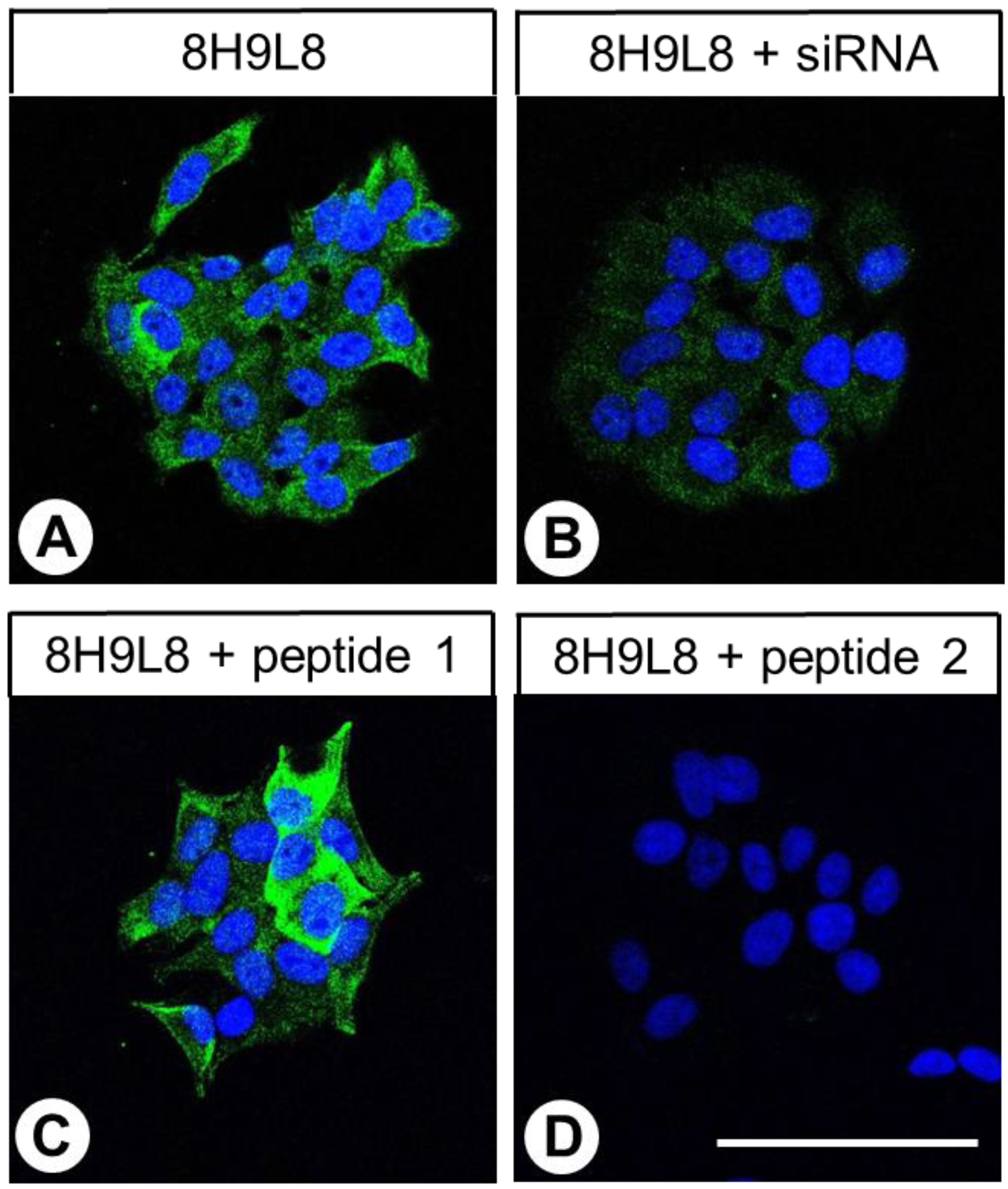
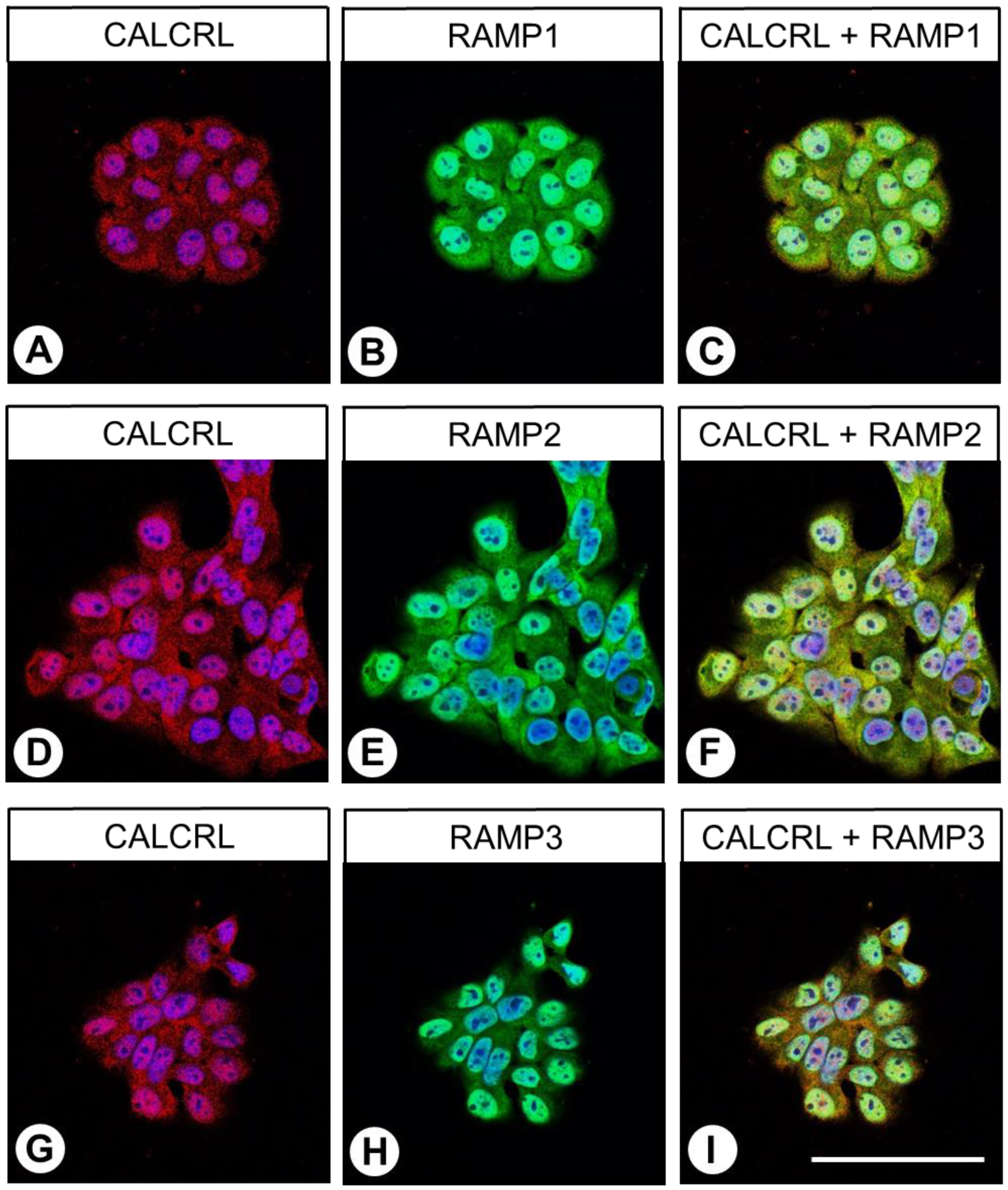
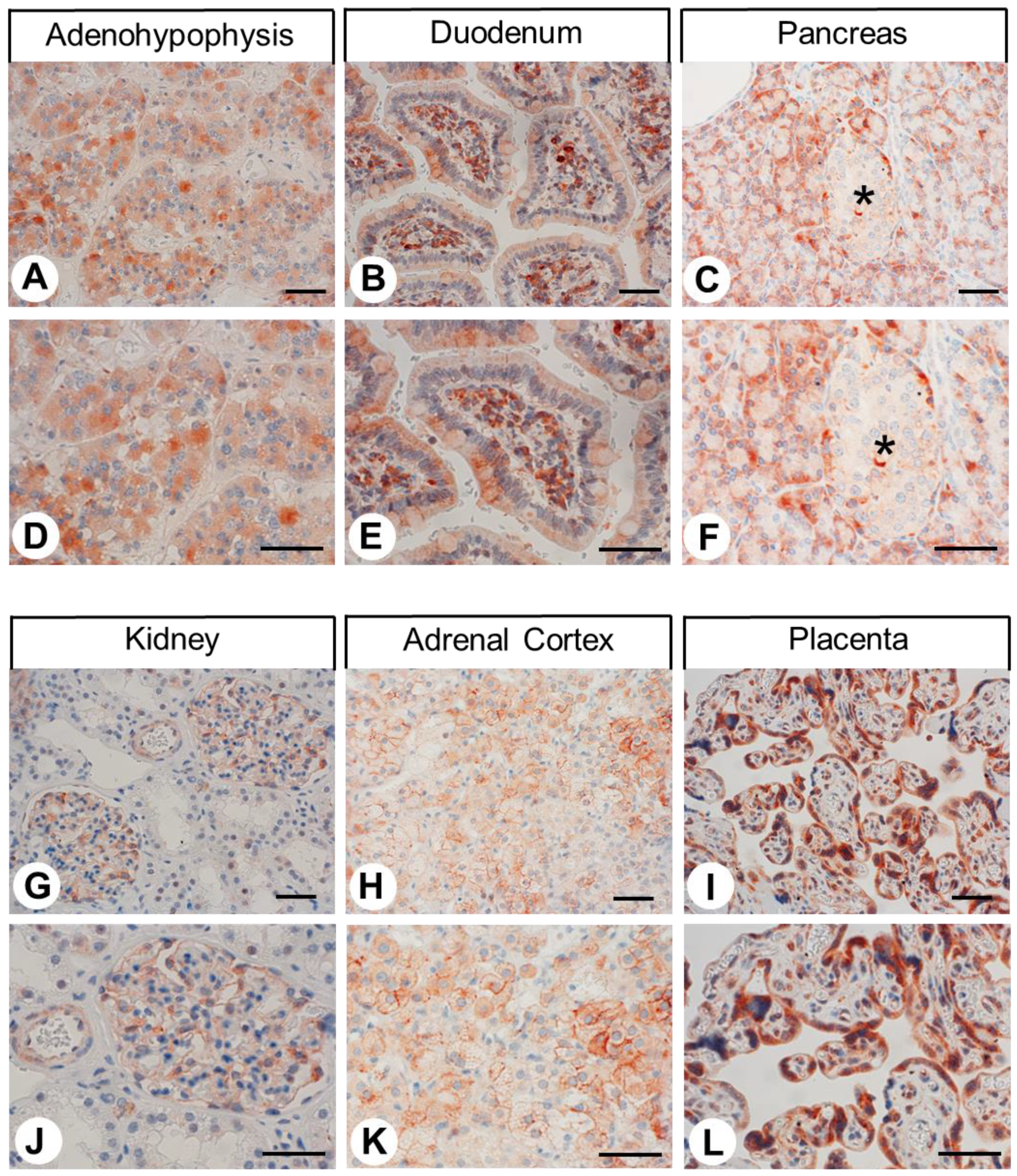
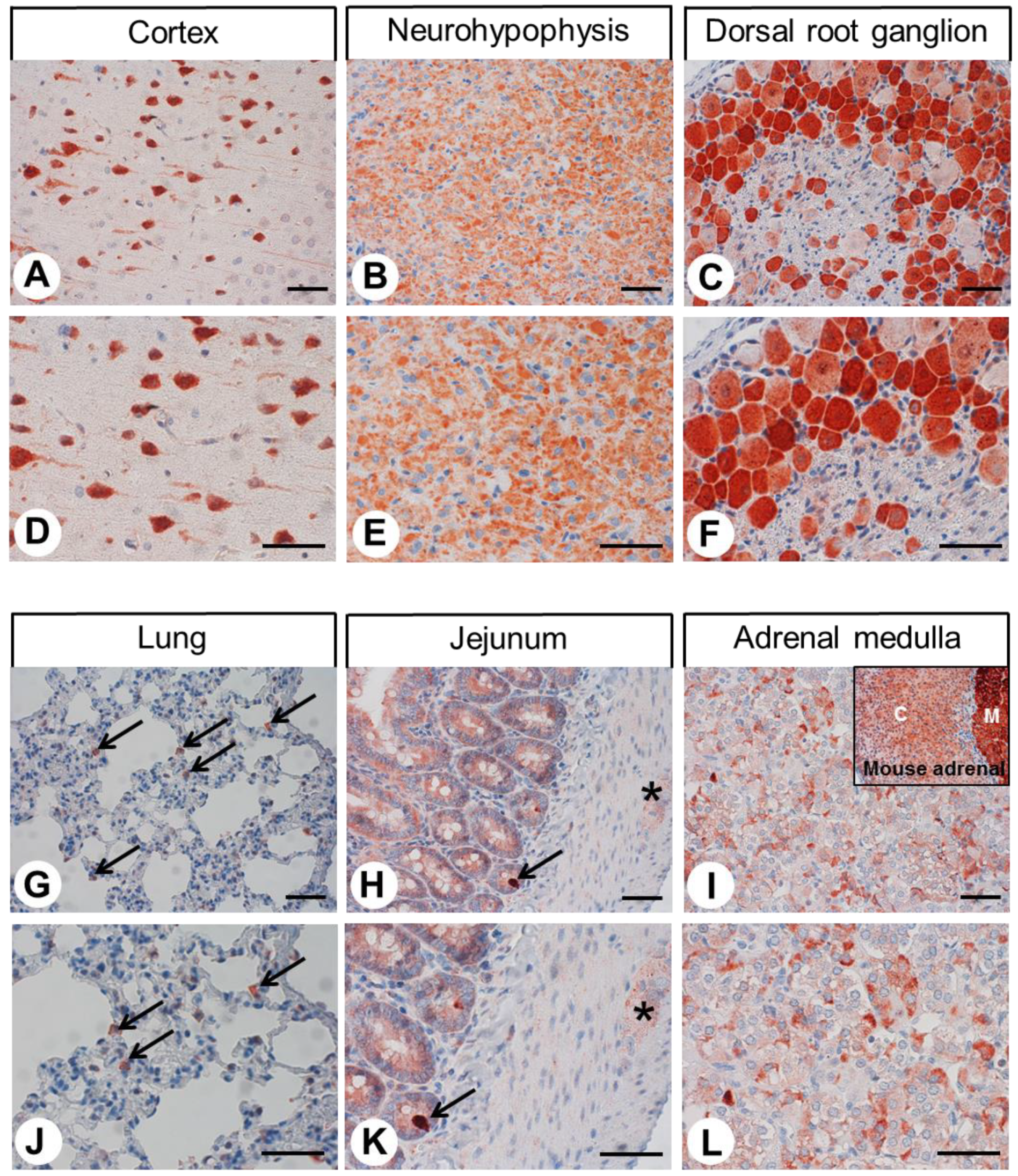
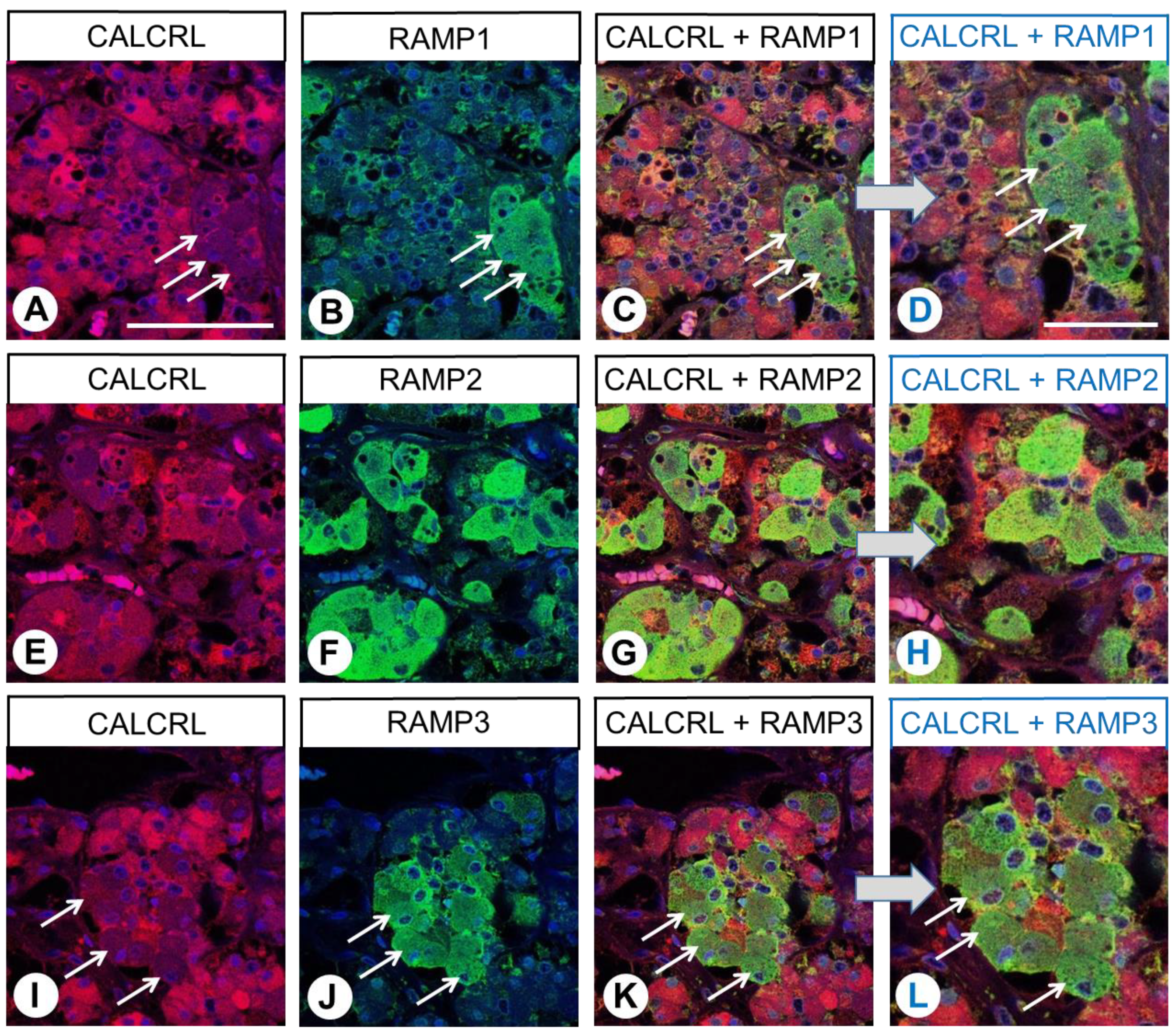
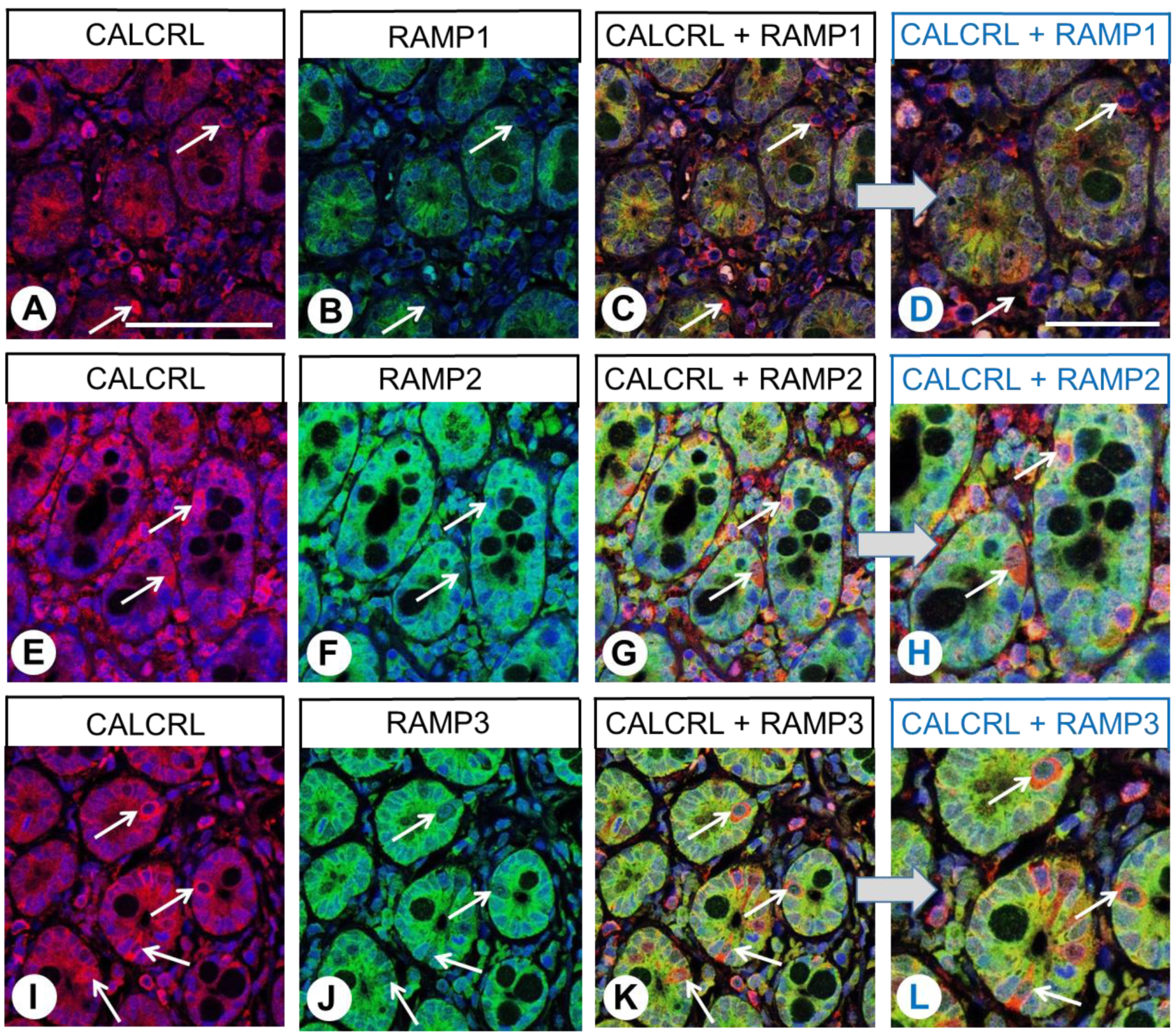
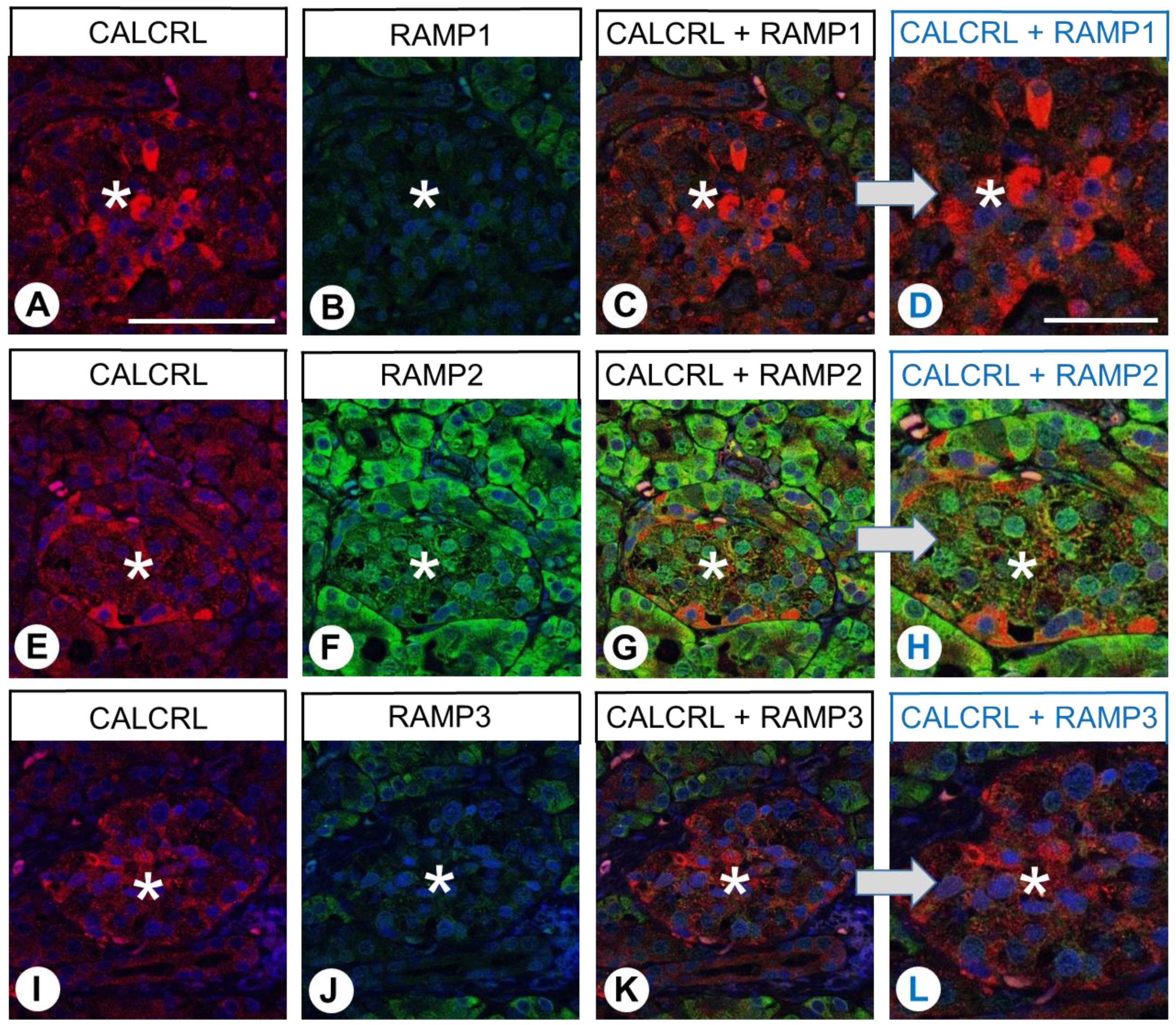

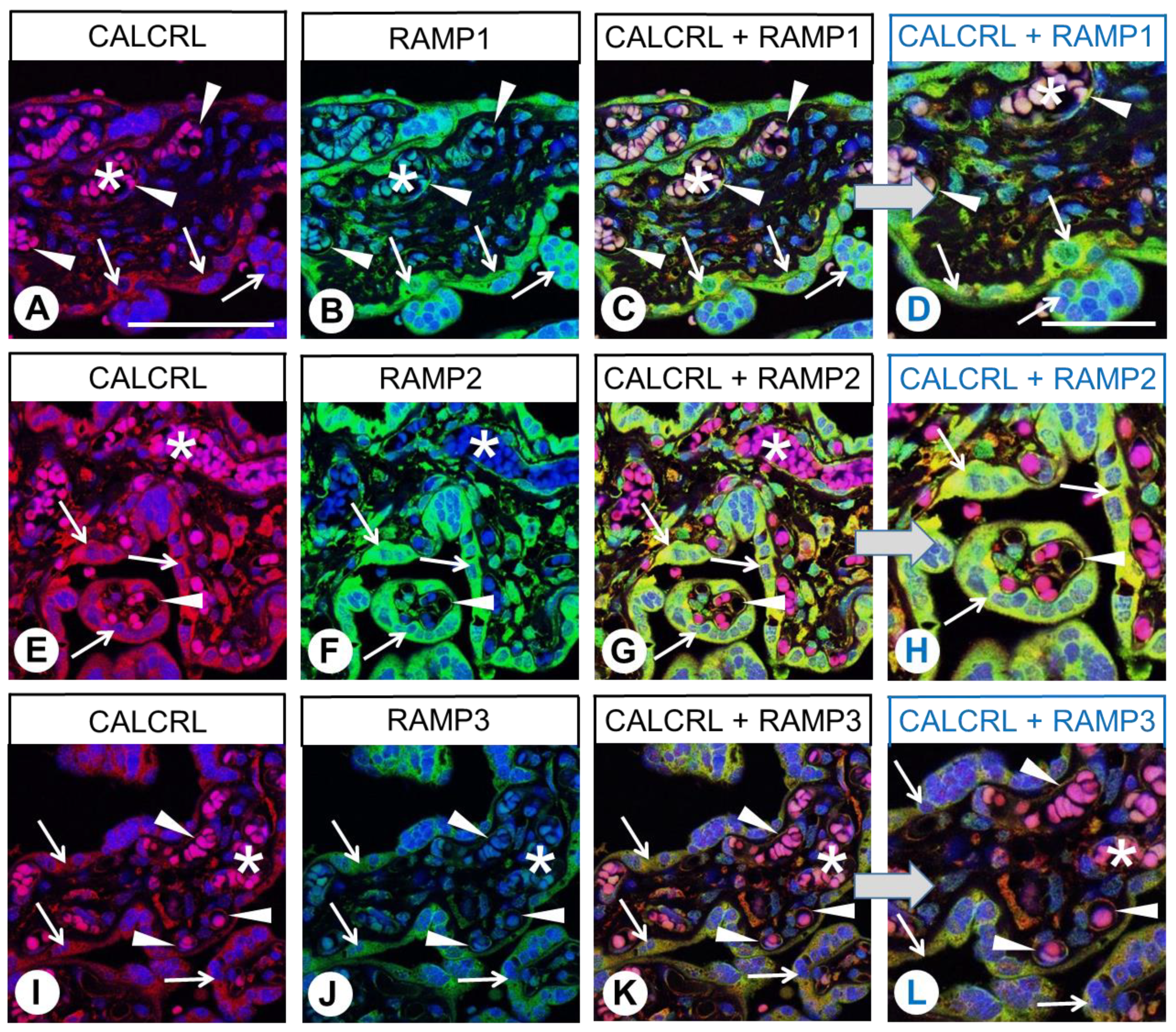
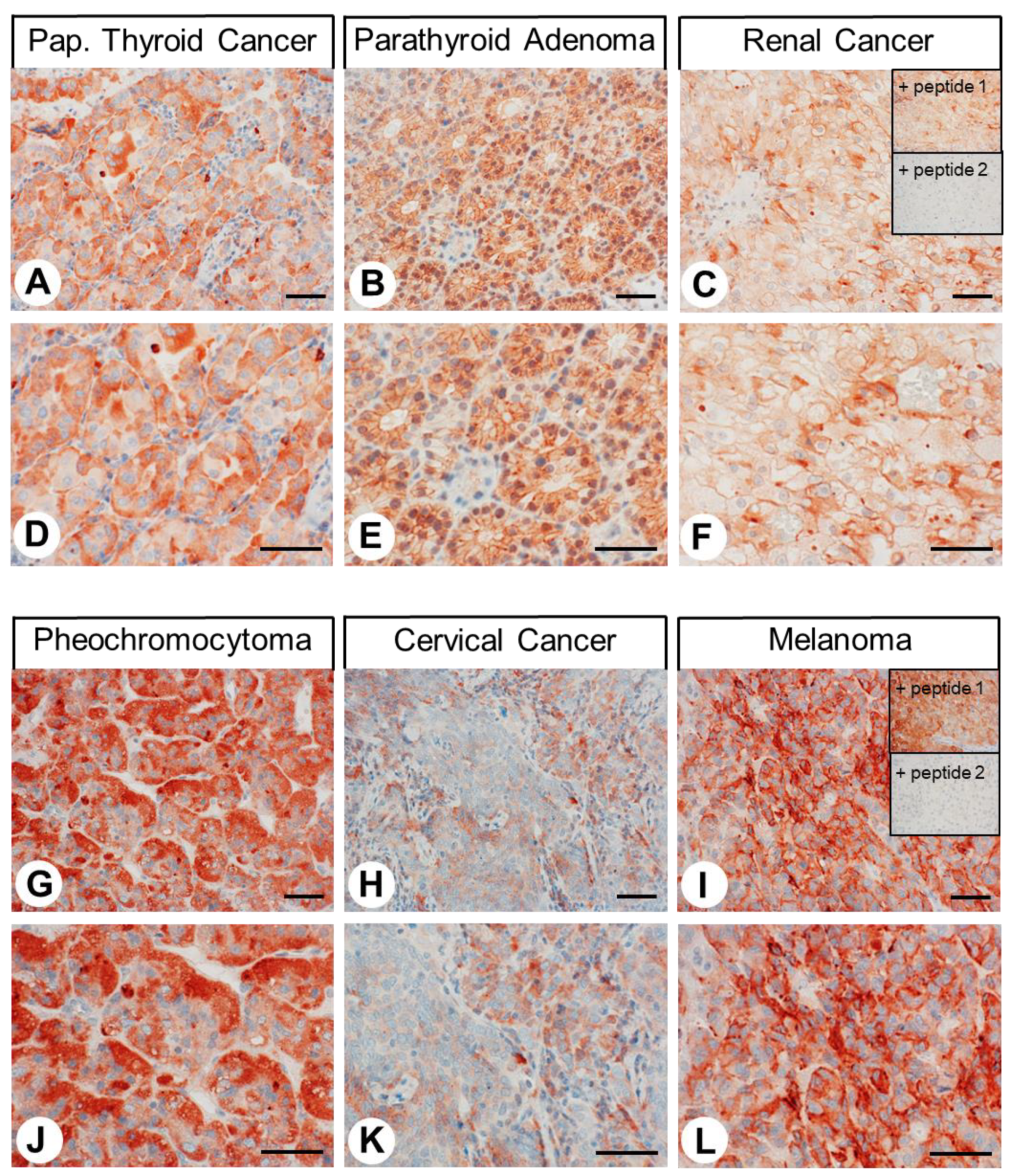
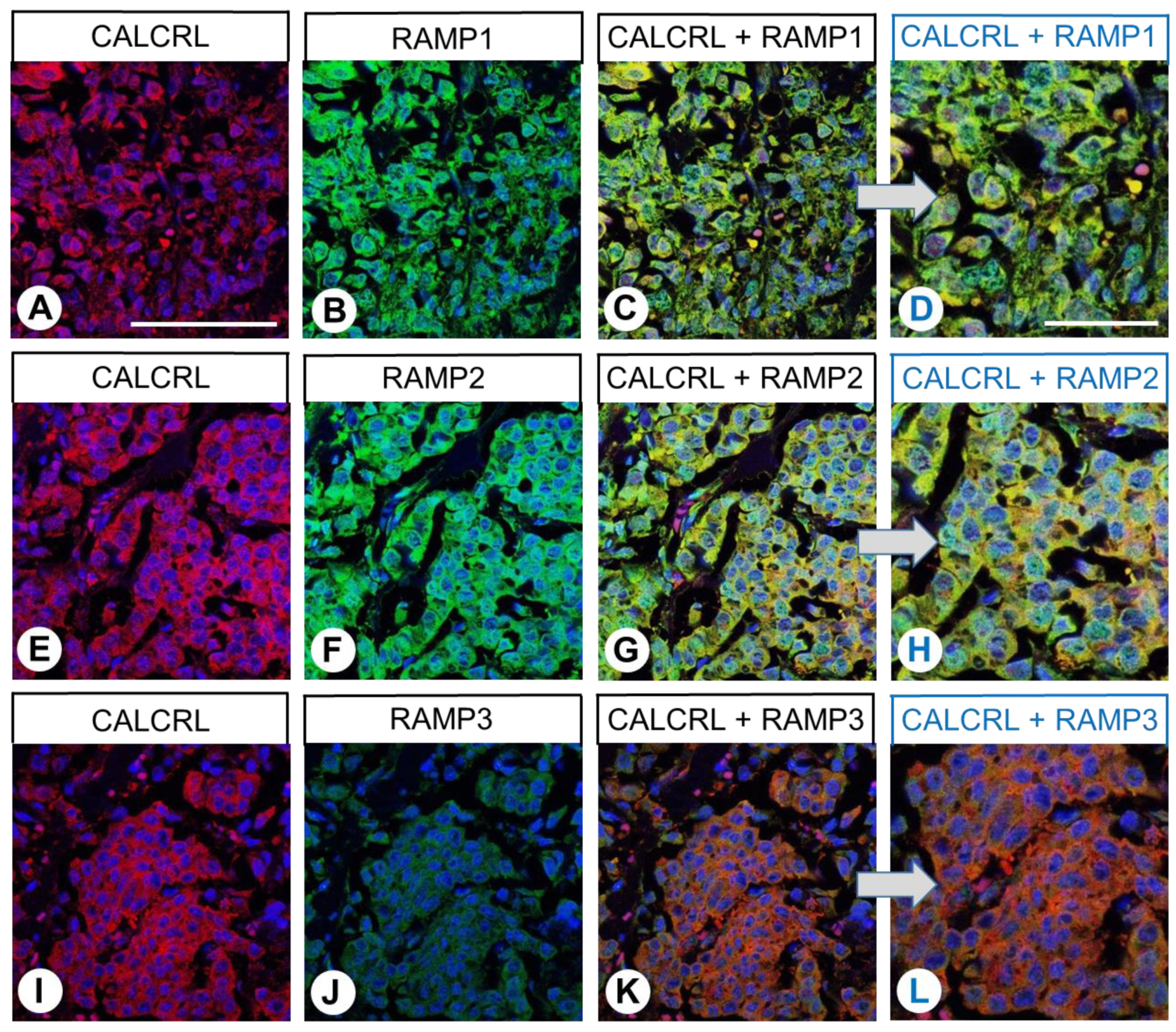

| Tumour Type (Number of Cases [n]) | CALCRL-Positive Tumours [n] (%) | IRS | |||
|---|---|---|---|---|---|
| Min | Max | Mean | SD | ||
| Glioblastoma (9) | 0 (0%) | 0 | 1 | 0.67 | 0.50 |
| Thyroid carcinoma (37) | 29 (78.4%) | 0 | 10.5 | 5.22 | 2.71 |
| - Papillary (11) | 8 (72.7%) | 2 | 10.5 | 5.82 | 3.48 |
| - Follicular (9) | 7 (77.8%) | 0 | 6 | 4.78 | 2.22 |
| - Medullary (9) | 8 (88.9%) | 1 | 9 | 5.33 | 2.12 |
| - Anaplastic (8) | 6 (75.0%) | 2 | 9 | 4.75 | 2.92 |
| Parathyroid adenoma (10) | 10 (100%) | 4 | 12 | 6.65 | 3.16 |
| Lung cancer (40) | 14 (35.0%) | 1 | 12 | 3.55 | 2.82 |
| - Squamous cell carcinoma (10) | 6 (60.0%) | 1 | 8 | 3.95 | 2.57 |
| - Adenocarcinoma (9) | 4 (44.4%) | 2 | 6 | 2.78 | 1.48 |
| - Small cell lung cancer (13) | 7 (53.8%) | 0 | 12 | 3.73 | 3.77 |
| - Large cell neuroendocrine carcinoma (8) | 3 (37.5%) | 1 | 8 | 3.63 | 2.83 |
| Gastric adenocarcinoma (16) | 1 (6.3%) | 0 | 6 | 1.66 | 1.42 |
| Colon carcinoma (8) | 4 (50.0%) | 0 | 6 | 2.38 | 2.00 |
| Gastrointestinal stromal tumour (10) | 0 (0%) | 0 | 2 | 0.50 | 0.82 |
| Pancreatic adenocarcinoma (8) | 4 (50.0%) | 0 | 6 | 2.81 | 1.96 |
| Intestinal neuroendocrine neoplasm (12) | 3 (25.0%) | 0 | 6 | 1.42 | 2.27 |
| Pancreatic neuroendocrine neoplasm (10) | 10 (100%) | 3 | 10 | 6.70 | 1.89 |
| Hepatocellular carcinoma (10) | 1 (10.0%) | 0 | 3 | 0.70 | 1.03 |
| Cholangiocellular carcinoma (10) | 3 (30.0%) | 0 | 6 | 2.30 | 1.89 |
| Renal clear cell carcinoma (12) | 10 (83.3%) | 2 | 9 | 5.46 | 2.25 |
| Urinary bladder cancer (7) | 2 (28.6%) | 0 | 3 | 1.14 | 1.35 |
| Pheochromocytoma (6) | 6 (100%) | 6 | 8 | 7.00 | 1.10 |
| Prostate adenocarcinoma (12) | 4 (33.3%) | 1 | 4 | 2.25 | 1.22 |
| Testicular cancer (12) | 2 (16.7%) | 0 | 6 | 1.50 | 1.68 |
| Breast carcinoma (9) | 0 (0%) | 0 | 1 | 0.67 | 0.50 |
| Endometrial cancer (10) | 2 (20.0%) | 1 | 3 | 2.10 | 0.57 |
| Cervical cancer (9) | 1 (11.1%) | 1 | 4 | 1.89 | 0.93 |
| Ovarian cancer (9) | 1 (11.1%) | 0 | 3 | 1.44 | 0.88 |
| Lymphoma (10) | 6 (60.0%) | 0 | 12 | 4.45 | 4.35 |
| Melanoma (5) | 4 (80.0%) | 3 | 10 | 6.60 | 2.61 |
| Leiomyosarcoma (3) | 0 (0%) | 0 | 1 | 0.25 | 0.50 |
| Rhabdomyosarcoma (3) | 0 (0%) | 0 | 0 | 0 | 0 |
| Liposarcoma (3) | 1 (33.3%) | 0 | 4 | 1.33 | 2.31 |
Disclaimer/Publisher’s Note: The statements, opinions and data contained in all publications are solely those of the individual author(s) and contributor(s) and not of MDPI and/or the editor(s). MDPI and/or the editor(s) disclaim responsibility for any injury to people or property resulting from any ideas, methods, instructions or products referred to in the content. |
© 2023 by the authors. Licensee MDPI, Basel, Switzerland. This article is an open access article distributed under the terms and conditions of the Creative Commons Attribution (CC BY) license (https://creativecommons.org/licenses/by/4.0/).
Share and Cite
Wende, B.; Beyer, A.-S.L.; Ruhnke, N.; Kaemmerer, D.; Sänger, J.; Schulz, S.; Lupp, A. Expression of the Calcitonin Receptor-like Receptor (CALCRL) in Normal and Neoplastic Tissues. Int. J. Mol. Sci. 2023, 24, 3960. https://doi.org/10.3390/ijms24043960
Wende B, Beyer A-SL, Ruhnke N, Kaemmerer D, Sänger J, Schulz S, Lupp A. Expression of the Calcitonin Receptor-like Receptor (CALCRL) in Normal and Neoplastic Tissues. International Journal of Molecular Sciences. 2023; 24(4):3960. https://doi.org/10.3390/ijms24043960
Chicago/Turabian StyleWende, Benjamin, Anna-Sophia Liselott Beyer, Niklas Ruhnke, Daniel Kaemmerer, Jörg Sänger, Stefan Schulz, and Amelie Lupp. 2023. "Expression of the Calcitonin Receptor-like Receptor (CALCRL) in Normal and Neoplastic Tissues" International Journal of Molecular Sciences 24, no. 4: 3960. https://doi.org/10.3390/ijms24043960
APA StyleWende, B., Beyer, A.-S. L., Ruhnke, N., Kaemmerer, D., Sänger, J., Schulz, S., & Lupp, A. (2023). Expression of the Calcitonin Receptor-like Receptor (CALCRL) in Normal and Neoplastic Tissues. International Journal of Molecular Sciences, 24(4), 3960. https://doi.org/10.3390/ijms24043960






